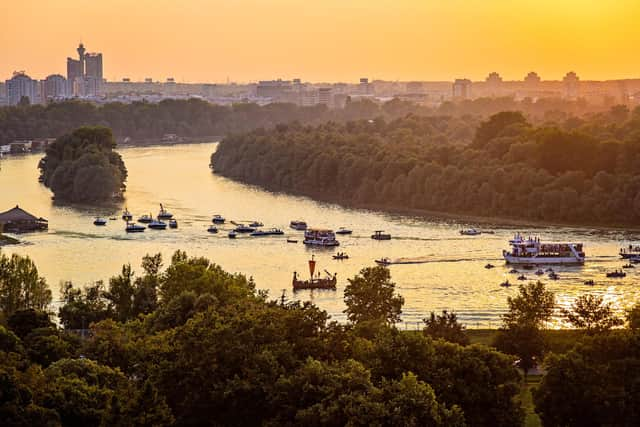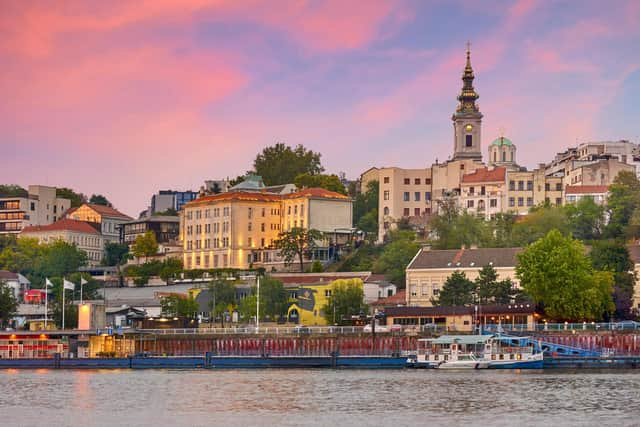Belgrade: Everything from The Busby Babes to great food at crossroads of Central Europe
The simple wooden table ahead of me is laden with dishes. Plates of cevapi (a type of mincemeat), sizzling grilled peppers and gibanica (a cheese filo pastry pie) form insurmountable food mountains, barely leaving any space for the shots of rakia (a double distilled fruit brandy) and pints of craft beer.
Walls stacked with jars and sauces make Manufaktura feel more like a larder than a restaurant. Tucking into some of Serbia’s favourite dishes in the city centre of Belgrade, I feel like the guest of honour in a private home.
Advertisement
Hide AdAdvertisement
Hide AdDelicious as the dinner might be, however, the evening’s highlight comes when the bill arrives. Costing a fraction of what I’d pay in London for a meal like this (around £10 per person), it’s a satisfying experience all round.


Although geographically part of Europe, Serbia is still outside the Eurozone. Especially welcome during a cost of living crisis, prices remain astonishingly cheap.
On October 31, British Airways resumed direct flights to the country’s capital, Belgrade, for the first time in 13 years. Operating three times a week, with a journey time of less than three hours, the service is perfectly set up for a leisurely city break.
Aside from the cheap booze and food, this is why you should go.
Advertisement
Hide AdAdvertisement
Hide AdLong before BA touched down, this city was in high demand. Due to its strategic position as a crossroads in Central Europe, Belgrade has been at the centre of more than 100 conflicts and has changed its name 15 times.


Known as Singidunum by a Celtic tribe in the 3rd century BC, it eventually became part of the Roman Empire. Later, it would fall under the Ottoman Empire and more recently was part of the former Yugoslavia. Even today, it straddles both Central Europe and the Balkans.
Inhabited up to 7,000 years ago, the land now known as Serbia has been a source of many archaeological treasures. Digs along the Danube River have unearthed multiple artefacts, including fragments of skulls which have been compared to those found in Ethiopia.
Among the pieces on display at the National Museum is an neolithic child’s spoon with teeth marks, ancient tools, and a votive of a chariot led by mallards dating to the 2nd millennium BC.
Advertisement
Hide AdAdvertisement
Hide AdIn 1958, Manchester United played Red Star Belgrade in the European Cup. A 3-3 draw was enough to earn them a place in the semi-final, but the event is momentous for more tragic reasons.
On the way home, the British team’s plane crashed, killing 23 people, including eight players and three members of the club’s staff.
The Busby Babes are commemorated with a plaque on the wall of the Majestic Hotel in the heart of the old town, where they stayed. There’s also a photograph taken a few days before before the accident, featuring Sir Bobby Charlton, who survived.
Imagine spending a fortune building not one but two palaces only to be booted out a few years later. That’s what happened to Serbia’s King Alexander I, who was assassinated before he properly had a chance to enjoy his Royal and White Palace.
Advertisement
Hide AdAdvertisement
Hide AdA decade later, his son fled to London during the Second World War when communists seized his riches.
The next heir was born in Claridge’s in London, where Winston Churchill had soil placed under the bed to temporarily declare it Yugoslavian territory.
When he returned in 2001, crown prince Alexander didn’t speak any Serbian but he was given access to his grandfather’s grand palaces.
Every Saturday, group tours of the complex are available (1000 RSD; royalfamily.org). Highlights include a library decorated with Italian Renaissance art and an ostentatious orientalist basement pool parlour, with a private cinema with a niche for a piano to accompany silent movies.
Advertisement
Hide AdAdvertisement
Hide AdAlthough very different in style to Gaudi’s ostentatious Spanish work, this shimmering masterpiece is equally unfinished – although it’s 97 per cent done.
Found in the eastern part of the Svetosavski Trg square, Saint Sava cathedral is located on the spot where its beatified namesake’s remains are believed to have been buried. Capable of holding 10,000 people at a time, it glitters with thousands of mosaics. Be blinded by the interior or arrive on the hour to hear 49 bells chime.
Monica Seles, Ana Ivanovic and Novak Djokovic all honed their strokes in Serbia. If you fancy picking up a racket, one of the most novel tennis courts can be found in the former moat of the Belgrade Fortress in the city’s Stari Grad district. After game, set and match, wander through the historic building to find ancient graffiti etched on the stone gates.
Packed with red squirrels, the surrounding Kalemegdan Park sits on the confluence of the Sava and Danube rivers and has an excellent viewpoint – although many visitors find their gaze travels to a naked male sculpture, amusingly erected on a pillar with a sword pointing at right angles from his waist.
Advertisement
Hide AdAdvertisement
Hide AdWhen a pint costs less than £3, any venue becomes appealing. But amongst the many places to quench your thirst, Belgrade has several outstanding options. Appealing to vinyl junkies, Leila Records (leila.rs) – just off the main Knez Mihailova promenade – sells cocktails, coffees and a curated selection of albums.
Spin tunes while sipping a Negroni for under a fiver. At Hyde Park in the elite Dedinje area, an eclectic mosaic of patchwork fabrics woven with trails of ivy create an outdoor interior, with a refreshingly affordable food and drink menu to (mis)match.
British Airways (ba.com) flies from London Heathrow to Belgrade three times per week, with return fares available from £104.
Comment Guidelines
National World encourages reader discussion on our stories. User feedback, insights and back-and-forth exchanges add a rich layer of context to reporting. Please review our Community Guidelines before commenting.